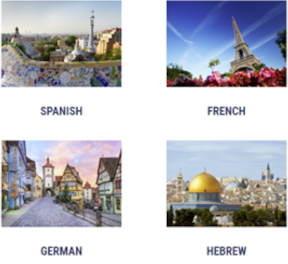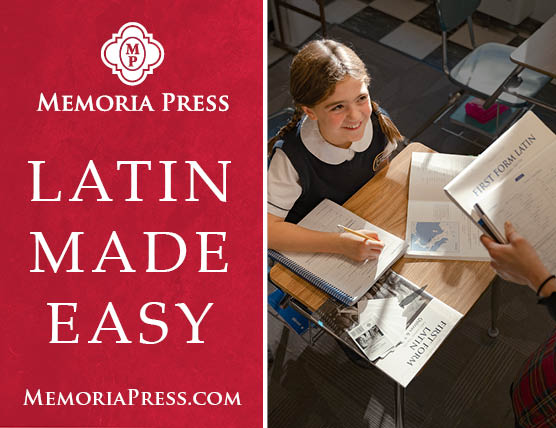The Learnable offers foreign language instruction in Spanish, French, German, and Hebrew that are downloaded and installed on most desktops and laptops but not Chromebooks or other mobile devices. Students still need an internet connection to work in the program after it's downloaded.
There are four levels in French, five levels in Spanish and German, and two in Hebrew. Purchases are by subscription, for either 12 or 24 months.
These courses are unusual in that they use an inductive, experiential method that is more natural than traditional approaches to foreign language acquisition. This is an immersion approach that uses illustrations and pictures with no text to build good listening skills that are essential in conversation. This type of learning happens prior to any reading in a foreign language.
The Learnables' methodology aims to develop understanding and comprehension first, then follow with reading, speaking, and writing skills in that order. This is similar to the way most of us learned English, except a child learns to speak before reading. The Learnables' emphasis is on vocabulary and understanding and, most importantly, learning to think in the foreign language.
For the most part, the same illustrations are used for each language, and most of the time each level for each language follows a similar plan. However, the sequence of sentences and some of the illustrations are specific to the language. All ages should start with Level 1. Lessons begin with words and short phrases whose meaning is obvious from the pictures. Translations are not given. If the student is in doubt, repetition of a word in another picture will likely clear things up. Sentences gradually become more complex as do the pictures. Pronunciation is very clear.
The courses also feature some games, photographs, and movies that enhance the learning process. The Fast Response Game included with subscriptions is to be used after students have finished Level 1.
It is impossible to correlate levels of this program directly with traditional language courses, although the combination of Learnables 1, Basic Structures 1, and Grammar Enhancement could be considered a first-year course. The publisher claims that the four levels of Spanish are equivalent to four high school years, while four levels of German and French are equivalent to 3.5 high school years. High school students should aim to complete the four levels (and probably the fifth level of Spanish as well) using all basic components available for each level. The specialized vocabulary books would be optional elements.
The program doesn't track test scores, so parents need to record those upon completion of a test.
Basic Structures and Grammar Enhancements
It should be sufficient for children in the early elementary grades to work through the online coursework. Older students need exposure to written forms of the language and its grammar. The Basic Structures and Grammar Enhancement programs from The Learnables add these elements.
Basic Structures programs are designed as companions for each level and are sold as part of subscription packages. Basic Structures is available for four levels of Spanish, three levels of French and German, and one level of Hebrew.
Basic Structures include pictures with phrases or sentences plus a very few reading and writing activities without pictures. The primary goal with Basic Structures is learning to read the language rather than learning to write it. Vocabulary in each Basic Structures program is very similar to that of the corresponding picture-based program. Students listen to the pronunciations, read the phrases and sentences, and sometimes do matching, fill-in-the-blank, or similar written exercises. (The fourth level for French uses a different format that includes paragraphs with pictures.) Basic Structures might be used with students from about fourth grade and up. Junior high and high school students definitely should use Basic Structures after completing each level of The Learnables picture books.
Grammar is not taught directly within either the picture-based lessons or Basic Structures programs, but students do acquire practical grammatical knowledge from actually using the language. At elementary levels, this does not present a problem as it does for high school where students are expected to study the grammar of whatever foreign language they are learning. This is where Grammar Enhancements come in.
Grammar Enhancement programs for Spanish, French, and German are included at the appropriate points within the subscription packages. Each Grammar Enhancement set includes a book and audio files. These are designed to be used after completion of Level 1 of a language, both the picture-based lessons and Basic Structures. Thus, you could have young children work through only the picture-based lessons, intermediate children then add Basic Structures, and teens continue through Grammar Enhancement. Alternatively, you could have students complete both Levels 1 and 2 before tackling Grammar Enhancement.
If you are trying to create something comparable to a typical first-year high school language course, Grammar Enhancement is essential alongside the Level 1 resources. Grammar Enhancement uses vocabulary from Level 1 and adds a great deal more. For example, in the Spanish course, the preterit tense is introduced in Grammar Enhancement but not in the other Level 1 resources. Yet, the preterit tense is typically taught in a first-year course. However, the order of teaching grammatical structures differs in immersion programs from grammar programs. In the end, students in an immersion program know not only the grammar but how the grammar is used in sentences to enable them to talk automatically without reference to grammar, just as we speak English.
Grammatically, Grammar Enhancement focuses on prepositions, pronouns, plurals, and verbs. The second course of Basic Structures continues teaching grammatical forms. The Grammar Enhancement contains the words from the audio files as well as pictures, but no instruction is given in English and no grammar rules are provided. Instead, many examples are given so students learn the sometimes subtle distinctions as they look for patterns and listen to the correct usage. This method might be more effective for some students than traditional instruction about grammar rules.
Advanced Courses
The advanced courses for German and Spanish help increase fluency with a collection of digitized books and audio files. Spanish students have available to them books on verb usage that teach the modals and all the tenses within the context of interesting stories. There are also specialized books on eating, transportation, walking, and placement (use of Spanish words for place, put, lift, reach, etc.). German students also have many optional advanced books that teach the important components of the German language in-depth.
Summary
None of the components requires any significant amount of writing, and there is no built-in requirement that students actually speak the language, although this is likely to happen naturally. If students really intend to learn to speak the language, there is really no substitute for immersion where the student listens to and converses with native language speakers.
However, The Learnables' approach can be more enjoyable than typical programs of either the textbook variety or the audio recordings that have you simply repeat the foreign language phrases after the speaker. The learner must think about what is happening in the pictures to understand the meaning. The illustrations used in The Learnables also add visual memory association to the words students hear, increasing vocabulary retention.








